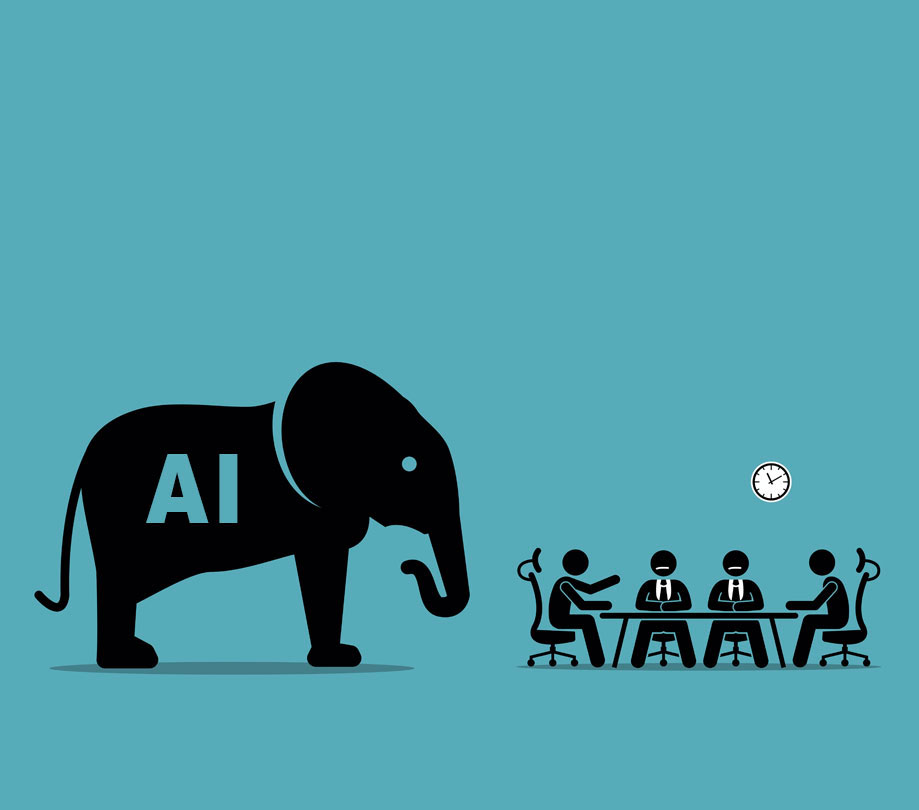4 barriers to AI Adoption
Tuesday, July 21, 2020

|
Richard Harris |
With all the hype around AI, why hasn’t every business started developing their own custom AI applications from the mountains of data companies have of customer, contract, employee, and IP information? Agiloft CEO and founder, Colin Earl talks to ADM exclusively about what’s holding businesses back from jumping on the AI train.
Some of the largest companies in the world are either already implementing, or are strategically planning for AI. And a recent study from Tractica found that global AI software revenue is expected to grow from $10.1 billion in 2018 to $126 billion by 2025.
But even with adoption by large companies, many businesses seem to be weary of jumping into AI - even when they have massive amounts of data that AI could help them learn from.
So what is preventing organizations from creating their own AI apps for business? Agiloft CEO and founder, Colin Earl, who is a software industry veteran who has worked at IBM, General Electric, and three start-ups before founding Agiloft, offers what he things are the the most significant barriers to AI adoption currently impeding businesses.
ADM: How are businesses strategically using their data?
Earl: Recent research from the McKinsey Global Institute shows that data-driven companies are 23 times more likely to acquire customers, six times as likely to retain those customers, and 19 times as likely to be profitable as a result. Data science is one of the most effective ways organizations can leverage readily available data sets. As more companies begin to increase efforts to incorporate artificial intelligence (AI) and machine learning (ML), data science is crucial to giving companies a competitive edge. In today’s evolving landscape, companies use data to gauge customer sentiment, conduct predictive analysis, and descriptive analysis. These methods enable companies to figure out what problems their customers are facing and how their products can solve them.
ADM: What opportunities are available to businesses that use data to create their own AI applications?
Earl: No-code AI presents a huge opportunity for businesses to capitalize on available data. This has spurred adoption of low-code and no-code solutions (a market expected to grow from $13.2 billion in 2020 to $45.5 billion by 2025), which allow users to implement their own applications when they need them without coding experience or IT intervention. Requiring even less time and resources than low-code, no-code is the next evolution in software development, and it is helping organizations across industries quickly build applications to address their organization’s unique needs. Furthermore, the combination of AI and no-code software provides organizations the power to analyze readily available data and use it in a way that provides quick business value. By integrating no-code AI solutions, businesses can more easily build highly customized enterprise workflows and reconfigure them in a matter of minutes based on user feedback or internal process changes.
Additionally, no-code AI software gives companies the opportunity to leverage readily available data that may be hidden away in contracts or other company documents. In the process of adopting applications with AI, companies can be overwhelmed with the amount of data available. No-code AI software eliminates this barrier by providing a quick and efficient way for users who are unfamiliar with software development and AI concepts to analyze and utilize large data sets. An example of this is using a no-code AI solution to automatically import, classify, and prioritize contracts for review in a contract lifecycle management (CLM) system. No-code AI allows companies to conduct analysis on data sets while also increasing operational efficiency with processes like contract management.
ADM: What’s holding businesses back from creating their own AI applications?
Earl: As AI and ML gain popularity and continue to evolve, more businesses are striving to integrate some form of AI into their technology. Research conducted by Tractica shows that global AI software revenue is expected to grow from $10.1 billion in 2018 to $126 billion by 2025. Despite the hype that AI adoption presents, businesses are still facing several barriers that impede implementation of AI:
- Fear of AI
The inherent fear of AI lies within the perception of massive job loss due to automation. However, AI and automation are most frequently used to extract or retrieve data, send out email reminders, and other menial administrative tasks, allowing employees to spend time more efficiently and on higher value projects. For paralegals and contract managers, AI platforms provide instant data on contracts and other documents, which improves efficiency and frees up employees to work on higher level tasks, increase interactions with clients, and provide additional business value.
- Mountains of Data
Another barrier that impedes businesses from adopting AI into applications is the overwhelming amount of data. With mountains of data to be analyzed, many businesses do not know where to begin, what to do with it, and how to abide by compliance regulations. Every business has the potential to break this barrier and use its own data to provide a competitive edge. In many ways, the more data, the better, as it provides an advantage in training AI solutions to be more accurate.
- Picking the right algorithm
Although choosing an effective algorithm is vital to integrating AI into applications, it is not an integral step in the early stages of adoption. In most cases, AI software developers create and establish the algorithms that are integrated into the solution. Whether it’s an out-of-the-box AI tool or a custom-built AI application, businesses can now implement AI with very little necessary customization.
- Shortage of data scientists
As enterprises begin to increase efforts to integrate ML and AI into solutions, data science is becoming mission critical. Data science is a vital step in identifying how available data can yield significant value. However, companies can look to upskill and train employees that are already familiar with the data to solve this challenge.
Specifically, AI has tackled numerous challenges within legal technology and contract management. As legal departments expand in response to increasingly complex regulations, AI adoption across legal departments is critical to optimize productivity and reduce risk. Whether to solve the need of paralegals struggling to keep up with regulatory compliance or contract managers manually updating agreement terms, integrating AI into workflow automation can eliminate human error and increase productivity. This is done by allowing users to set up business policies and rules within a CLM system that apply to the flow of tasks, documents, and information across business activities.
ADM: What role does no-code play in increasing adoption of AI applications?
No-code plays an integral role in how companies integrate AI. Because no-code software is highly configurable, companies can quickly integrate AI solutions and continue to configure them to fit company workflows and changing business needs.
ADM: What is no-code AI and how does it benefit companies?
In today’s digital age, traditional methods of software development are becoming obsolete. As companies continue to grow and keep up with market demands, it is necessary to implement software tools that can be rolled out in a timely manner, without an exorbitant amount of work.
No-code AI is quickly revolutionizing the industry and leaving traditional, code-heavy software development behind. By utilizing AI and ML, organizations can efficiently classify, extract, and analyze data. Not only do no-code platforms allow for software development without writing any code, they also are extremely configurable and can adapt to meet any customer need. No-code AI offers companies a plethora of benefits, including:
Moldable and Scalable
One of the most prominent benefits of utilizing no-code AI solutions is its ability to be molded to meet the enterprise’s needs, regardless of company size or vertical. For example, no-code AI can be used in contract management to identify contract clauses or to score the level of risk in clauses based on preconfigured rules.
Quick Deployment
While traditional methods of software development may take months or years to deploy, no-code software development allows companies to integrate solutions within weeks, cutting the time of deployment by up to 80%.
Use of AI and Work Automation
As more organizations adopt AI and ML, companies within the legal, government, education, and healthcare industries are jumpstarting initiatives to incorporate no-code AI software into applications. Companies are using it to meet business needs quickly and mitigate the risks associated with deploying digital systems. By combining AI, ML, and no-code, companies can establish flexibility within workflows, which ultimately creates more time for employees to build on customer relationships and drive additional business value.

Colin Earl, CEO of Agiloft
Agiloft CEO and founder, Colin Earl, is a software industry veteran with over 25 years of experience as a developer, product manager, and CIO. Colin worked at IBM, General Electric, and three start-ups before founding Agiloft in 1991. His vision was to accelerate the building and deployment of enterprise business applications by removing the need for manual coding. Under his leadership, Agiloft has achieved this goal, creating a market segment for agile business software. Colin's focus is on growing a world-class team and aligning the interests of staff, partners, and customers. He has an engineering degree from Imperial College, and moved to Silicon Valley in 1986.

Become a subscriber of App Developer Magazine for just $5.99 a month and take advantage of all these perks.
MEMBERS GET ACCESS TO
- - Exclusive content from leaders in the industry
- - Q&A articles from industry leaders
- - Tips and tricks from the most successful developers weekly
- - Monthly issues, including all 90+ back-issues since 2012
- - Event discounts and early-bird signups
- - Gain insight from top achievers in the app store
- - Learn what tools to use, what SDK's to use, and more
Subscribe here




_cptybzmh.jpg)








